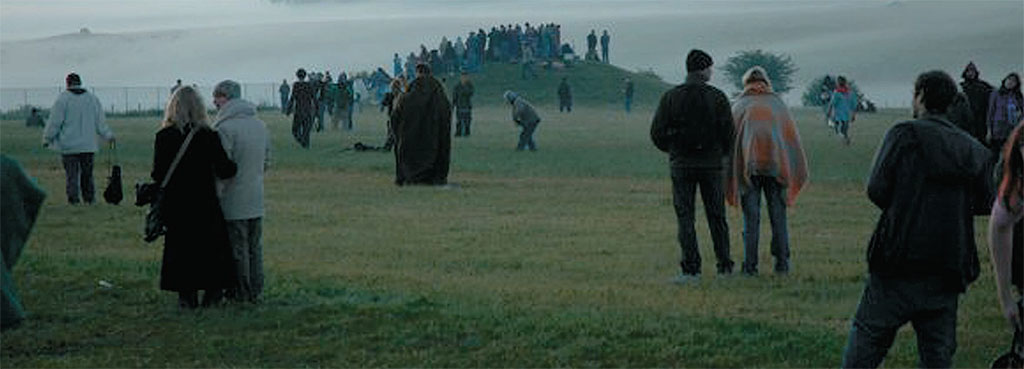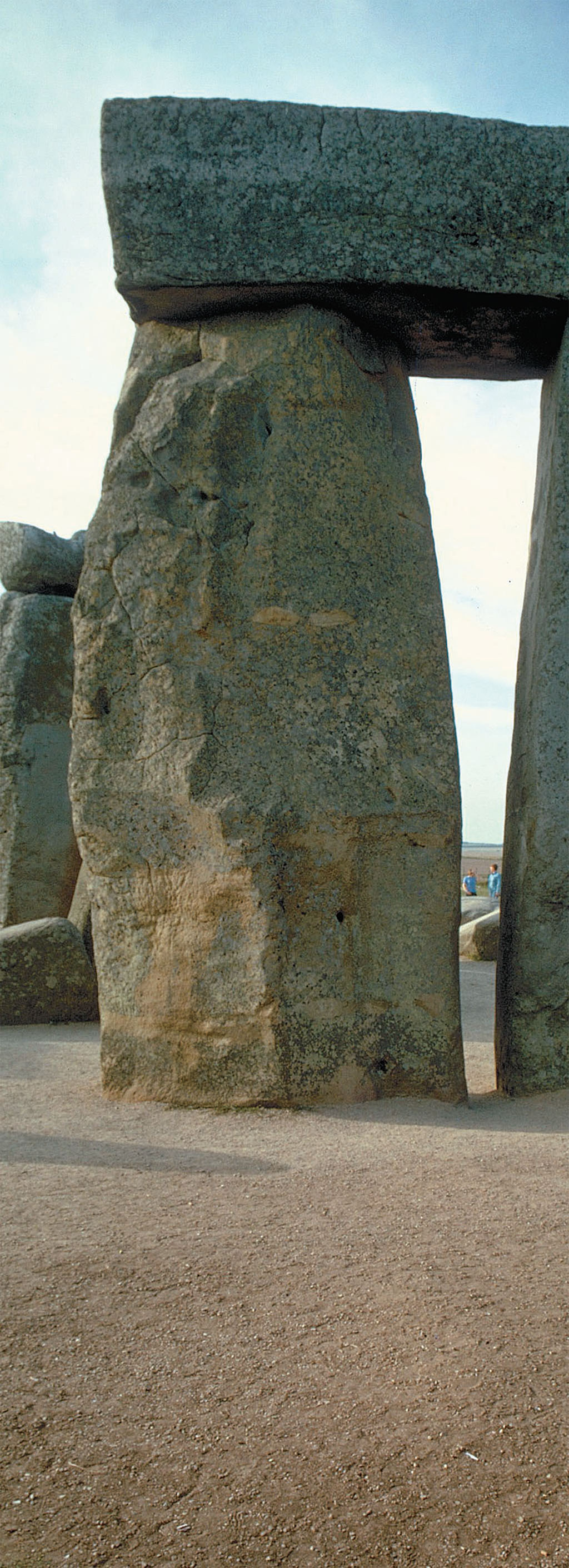
[caption id="GuardingtheStones_Feature" align="aligncenter" width="1024"]

RACHEL FOSTER
ON THE 21ST OF JUNE, A BALL OF CRIMSON FIRE climbs up from the horizon to be met with rapturous cheers, drumming, dancing, singing and applause. It is the best midsummer sunrise in five years, and more than 21,000 people have assembled at Stonehenge in Wiltshire to witness it. What they do not realize is the enormous amount of work that has gone into managing this event, and in guaranteeing that conservation needs are met without dampening the spirit of a ceremony that has been fundamental to the British calendar for many years.
A few hours before sunrise, the view is much less picturesque. I am shivering in a cold, uninspiring car park a mile away from Stonehenge. Tired, bleary and wearing an attractive fluorescent orange jacket, I have been trying to persuade an irate man to part with a 7-foot trident that he wants to take with him onto the site. He shows no signs of giving it up soon. It is immense—a tree trunk with pitchfork prongs ingeniously embedded into the wood. He swings it around as he talks, forcing those standing nearby to duck or risk impalement. I am starting to wonder why exactly I am here at 2:30 in the morning, and not tucked up in bed safe from the perils of homemade ceremonial weapons.
I am a volunteer steward for English Heritage, charged with the rather daunting task of protecting Britain’s most iconic monument from the thousands of merrymakers who come to spread love, peace and litter for miles around.
English Heritage is the national body established by Parliament in 1984 to protect our historic environment, and to promote public understanding and enjoyment of it. It sounds straightforward, but these two objectives—protection and enjoyment—often contradict each other, and there is no better time to see this than the solstice.
[caption id="GuardingtheStones_img1" align="aligncenter" width="561"]

GEMMA AMOR
The chief executive of English Heritage, Simon Thurley, highlights the balance that needs to be struck: “Summer solstice is a special time, which means different things to different people. We have to work closely with many agencies and people from all sectors of the community to ensure that everyone who comes to solstice is able to enjoy the occasion safely and peacefully.”
[caption id="GuardingtheStones_img2" align="aligncenter" width="1024"]

GEMMA AMOR
The organization, alongside the National Trust, Ministry of Defence, Wiltshire Constabulary and many local farmers and householders, is responsible for implementing the Stonehenge World Heritage Site Management Plan, which covers 2,600 hectares of prehistoric beauty and more than 400 ancient scheduled monuments. This scheme does not have much room for the lighting of fires; climbing, standing, dancing or opening beer cans on the stones; or relieving oneself against or daubing the monument in fluorescent profanities—even if it is for only one day a year. The actions of a few can easily destroy the enjoyment of many; thus, the annual balancing act ensues.
A shadow cast over the event in the 1980s has taken many years to disperse. The Battle of the Beanfield in 1985, when police “ambushed” travelers on their way to the solstice, became the focus of such hype and furor that events in following years were dampened by an oppressive, angry atmosphere. Fences went up, and an Exclusion Order had been enforced in 1984 that established a four-mile zone around Stonehenge. This was lifted only to allow special access for those who booked in advance, and gave resentful troublemakers the excuse they needed to storm the fences in 1999.
The outcome of all this was the opposite of what could have been expected—Managed Open Access. When it was recognized that previous disturbances were caused by a hostile minority, the decision was made to not let their behavior compromise the experience of others who came to enjoy the World Heritage Site. The fences came down, and volunteer stewards were recruited to patrol the event and keep a beady eye out for trouble. This is where my orange jacket and I come in.
Our brief is quite intimidating. We are led through emergency procedures, lost child policy, suspicious packages, confrontation protocol and what to do with broken glass and syringes. There are yellow jackets, orange jackets, police and peace stewards (representatives for the Druid community) all over the site. They all look distinctly unfazed as they pick their way through sleeping Druids, musical instruments, blankets, bongos, bags of rubbish and forgotten children. The air of chaos and excitement is palpable, and I cannot help but wonder what this place would have looked like a thousand years ago on this day.
Stonehenge was built in such a way that it aligns with the midsummer sunrise and the midwinter sunset, leading to the most widely held theory that it was constructed as an instrumental part of ritual ceremony, and was used as such for more than 1,000 years. The original rituals may have taken place over a much longer time frame.
[caption id="GuardingtheStones_img3" align="aligncenter" width="1024"]

WWW.BRITAINONVIEW.COM
“Without the benefit of sophisticated measurements it is very difficult to observe the solstices with the current degree of precision. It is possible that the prehistoric celebrations were spread out over a number of days when the sun appears on the solstitial alignments,” says Dave Batchelor, local authority historic environment liaison for English Heritage. Such a long celebration must have been one of the most anticipated events of the year—and it becomes easier, in light of the history of the ceremony, to see why it is so important to get things just right.
As the crowds start to disperse after sunrise, it is obvious that Managed Open Access is a big hit. Most people are curled up in inoffensive lumps in the ditch, fast asleep. The remainder are happy to clean up their own litter. Only a few are climbing on the stones themselves, and they are easily dislodged. I had no call to use any of the precautionary measures in which I had been briefed. The mounted police that turn up later to clear the site are not needed—in the heat of a midsummer’s day no one has the energy or will to object. People drift away in happy but exhausted drabs. The Battle of the Beanfield is nothing but a distant memory.
Peter Carson, Stonehenge director, is delighted by the progress. “Enormous strides have been made here since 1985. Over the last five years, the event has been a peaceful celebration enjoyed by thousands of people. Since Stonehenge was opened for summer solstice celebration in 2000 there has been no major damage to any of the stones as a result of the public access.”
By early afternoon, the site is deserted. I take the opportunity to wander into the stone circle before it is reopened for business as usual. The only other visible person is Tony Leach, property maintenance manager, kneeling on the altar stone and dabbing at a small patch of blood with painstaking care. All other traces of the event have vanished. Peace and quiet returns to the Wiltshire countryside, and it is hard to imagine that a few hours earlier I was hemmed in on all sides by thousands of people jostling to get a good view of the sunrise.
I am proud of my part in the Managed Open Access initiative. Volunteering cost me nothing but a few hours’ sleep, and gave me access to an exciting, vibrant experience that will be hard to forget. And it was worth it just to see the wide smile of relief on the face of the man who was reunited with his beloved trident.
For more information on English Heritage visit www.englishheritage.org.uk.
[caption id="GuardingtheStones_img4" align="aligncenter" width="1024"]

©TIMM PAGE/CORBIS





Comments